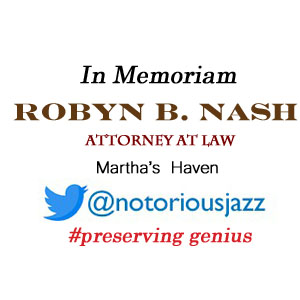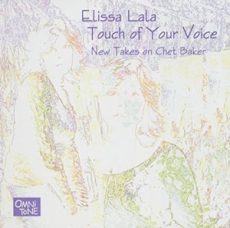
Daily Dose Of Jazz…
Elissa Lala was born on April 30, 1958 in Philadelphia, Pennsylvania, the daughter of a professional trombonist. She began singing professionally at the age of five and by the time she was in her early teens she was doing background vocal sessions at Philadelphia’s Sigma Sound Studios. Although heavily influenced by R&B, she would be quietly singing Michel Legrand’s You Must Believe in Spring while walking to that all girl Italian high school.
Struggling with a hearing impairment never affected her pitch and falling in love with jazz guitarist John Valentino made the jazz thing stick. The couple performed together at every major venue on the east coast, eventually marrying and moving to Los Angeles, California. While singing at a Burbank studios jazz club, Aaron Spellings’ music supervisor heard Lala and hired her to sing All the Things You Are for the ABC miniseries Crossings.
More film and TV studio work came her way and her credits multiplied. A bout with tinnitus led to more hearing loss and learning about hearing loss. Elissa became trained in hearing instrument fitting and helped hundreds of hearing-impaired children and adults hear better through the use of digital hearing instruments.
As a lyricist she wrote for Ralph Towner’s I Knew It Was You. She has written and/or recorded with Blue Note recording artists Pat Martino, Narada Michael Walden, Michel Legrand, Alex Acuna, Tommy Tedesco, and Bennie Maupin. Her approach to improvisation is fresh, moving, and very in the moment, or documented, recorded or live.
Vocalist Elissa Lala continues to perform, work in film and television, and tour.
More Posts: bandleader,history,instrumental,jazz,music,vocal
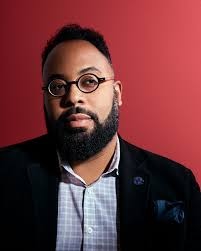
Jazz Poems
STARDUST
Lady singsthe blues
the reds, whatever
she can find—
short
changed, a chord—
God bless
the child
that’s got his own
& won’t mind
sharing some—
“BILLIES BOUNCE”
“BILLIES BOUNCE”
Miss Holiday’s up
on four counts
of possession, three-
fifths, the law
—locked up—
licked—the salt
the boot—refused
a chance to belt
tunes in the clubs—
ex-con. Man,
she got it
bad—Brother
can you spare
a dime
bag? MEANDERING
WARMING UP
A RIFF—
she’s all scat,
waxing—
SIDE A
SIDE B
OOH
SHOO DE
OBEE—
detoxec, thawed
in time
for Thanksgiving—live
as ammo, smoking
—NOV. 26 1945—
Day cold as turkey
KEVIN YOUNG
from Jazz Poems ~ Selected and Edited by Kevin Young
More Posts: book,classic,collectible,history,jazz,library,poet
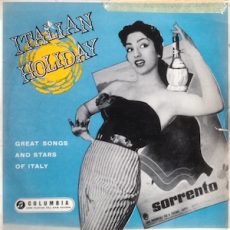
Daily Dose Of Jazz…
Andrea Ventriglia was born in Capua, Italy on April 29, 1953 and studied the saxophone with the masters Franco Florio in Salerno and Eraclio Sallustio at the GB Martini Conservatory in Bologna, Italy. He later studied the flute with Aldo Ferrantini.
His professional career began while he was still a music student around the end of the 1960s, following the rhythm & blues and soul of James Brown, Wilson Pickett, Aretha Franklin, Ray Charles and Joe Cocker in fashion at that time and still today. At a very young age he was part of the best and
As a soldier Andrea was part of the National Band of the Italian Army. He moved to Verona, Italy in the mid 1970s and began playing in small bands in night clubs. He was invited to join the Big Band Citta’ di Verona directed by Maestro Mario Pezzotta, in the first tenor saxophone. At the same time he performed in Fernando Brusco’s small orchestra as an arranger and saxophonist.
Moving to the United States he initially played in small bands that performed on cruise ships where he met among others Count Basie, Mercer Ellington, Sarah Vaughan, Harry James and Bob Crosby. Settling first in San Francisco, then in Los Angeles, California he played on the road with small bands collaborating with Harry James and Bob Crosby in the latter city.
Back in Italy he gained membership into Franco Rosselli’s orchestra and did the night club circuit in Florence, San Remo and Riviera Romagnola. Leaving Roselli he toured with Bobby Solo throughout Italy. His passion for jazz and big band led him to the Luciano Fineschi Orchestra, again sitting in the first tenor saxophone and flute chair.
After the orchestra disbanded Ventriglia went on to play in other big bands, duos, artistic partnerships, and guest appearances. For a decade he was a professor of saxophone at the Giuseppe Martucci Music High School in his hometown. He trained musicians currently working with famous artists or with their own groups and some of whom practice the profession of musician in the USA.
By the Eighties the public became more sensitive towards jazz, so Andrea led quartets performing in various Italian jazz clubs. that sprung up a bit everywhere in Italy. During his career and for professional reasons, saxophonist and flutist Andrea Ventriglia has performed on nearly every continent and continues to perform, tour and record.
More Posts: bandleader,flute,history,instrumental,jazz,music,saxophone
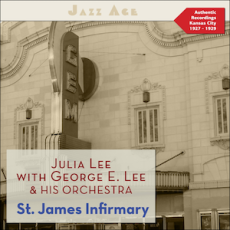
Daily Dose Of Jazz…
George Ewing Lee was born April 28, 1896 in Boonville, Missouri, and was the older brother of pianist and singer Julia Lee. They performed with their father’s string trio at neighborhood house parties and church socials. He played in a band while serving in the Army in 1917, and following this period, he sang in a vocal quartet.
In 1920 he formed and led George E. Lee Novelty Singing Orchestra and with his sister as one of the group’s members, he was a regular performer at Lyric Hall in Kansas City, Missouri through much of the 1920s.
Though he played many instruments, singing was his forte and he had a powerful voice and a penchant for ballads and novelty songs. Through the 1920s no group in Kansas City could compete vocally with the Lee Orchestra.
In 1927 they recorded as an octet with Jesse Stone on piano, for Meritt Records. Among the tunes was Down Home Syncopated Blues, and was the earliest recording of Julia Lee’s voice. They recorded six tunes for Brunswick in 1929.
In 1933, his group was absorbed into the Bennie Moten Orchestra. By 1935 he continued to perform with smaller ensembles through the decade. In 1937, at a resort in the Ozarks, Lee fronted a small group that included 17 year-old saxophonist Charlie Parker. Two years later he struck out on his own again, moved to Jackson, Michigan in 1940 and retired from music in 1941. He began
By the 1940s, he moved to San Diego, California. Vocalist and bandleader George E. Lee, who was sometimes billed as the Cab Calloway of the Middle West, died on October 2, 1958.
More Posts: bandleader,history,instrumental,jazz,music,vocal

Requisites
Focus ~ Bill Hardman | By Eddie Carter
This morning’s discussion is a terrific album by Bill Hardman. Focus (Muse Records MR 5259) is his fourth release as a leader, and a hidden gem in his catalog. Bill was born and raised in Cleveland, Ohio, where his jazz journey began playing with Tadd Dameron while in high school, and after graduating, with Tiny Bradshaw. His first recording with Jackie McLean in 1956 marked the beginning of a career that, although not widely known, earned deep respect in jazz circles for his exceptional trumpet and flugelhorn performances. On this album, Bill’s trumpet is joined by Slide Hampton on trombone (tracks: A2, A3, B1, B3), Junior Cook on tenor sax, Walter Bishop Jr. on piano, Mark Elf on guitar (B2), Stafford James on bass, and Leroy Williams on drums. My copy is the 1980 U.S. stereo release.
Side One is off to the races with Avila & Tequila by Hank Mobley. Leroy opens with a spirited introduction, accompanied by Walter and Stafford, setting the stage for the ensemble’s collective theme. Bill soars through the opening solo energetically. Junior’s following statement is brimming with dynamic energy. Walter maintains the vigorous momentum next, and Leroy charges the finale in a short workout, culminating in the theme’s reprise and fadeout. The sextet eases into the medium melody of Cubicle by Walter Bishop Jr. Bill gets into a good groove on the lead solo. Slide has an outstanding moment before Junior takes over to put his ideas into practice. Walter wraps it up before the restatement and exit.
Up next is Bill Lee’s Too Little, Too Late. The sextet’s medium-tempo introduction and melody start things off. Bill gets things going with a relaxing interpretation, then Slide moves with unhampered ease in the following solo. Junior jumps into a short, articulate statement next, and Walter wraps things up with a satisfying conclusion, preceding the closing chorus. The title tune, Focus by Tadd Dameron, changes the direction to begin the second side with the ensemble’s upbeat introduction and theme in unison. Slide steps up first to give a lively solo. Junior glides over the rhythm section with agility and skillful confidence next, then Bill attacks the following reading with virile lyricism. Walter continues conveying happy thoughts on the piano, and Stafford takes a short walk leading to the ending theme.
My One and Only Love by Robert Mellin and Guy Wood begins with Walter’s introduction, setting the mood for Bill’s tender melody with Junior shadowing him as it unfolds. Junior tells a touching story in the opening statement, then Mark delivers notes of great beauty in his only solo spotlight. Bill follows with a passionately haunting interpretation preceding his return to the gentle ending theme and soft climax. Minority by Basheer Qusim takes off like a race car with Leroy leading the sextet into a speedy melody. Bill goes to work first with a spirited solo, then Junior cooks at the right temperature. Slide infuses the following reading with riveting urgency. Walter builds the following statement exquisitely, and Leroy shines in a short workout before the melody’s restatement and finale.
Fred Seibert produced Focus, and the recording engineer was Fred Miller. The album is a joy to listen to, with a superb soundstage that brings the musicians to the sweet spot in your listening room with stunning fidelity. Bill Hardman recorded only five albums as a leader, but his discography as a sideman is extensive, including with Art Blakey and The Jazz Messengers, Lou Donaldson, Charles Mingus, and Horace Silver. He also co-led a group with Junior Cook but ultimately remained little known to the general public. He died on December 6, 1990, from a brain hemorrhage at age fifty-seven. If you’re a hard bop fan, I invite you to check out Focus by Bill Hardman on your next vinyl hunt. It’ll reward you with many hours of listening pleasure, especially if you’re a fan of jazz trumpet!
~ Jackie’s Pal (Prestige PRLP 7068) – Source: Discogs.com
~My One and Only Love – Source: JazzStandards.com
© 2025 by Edward Thomas Carter
More Posts: choice,classic,collectible,collector,flugelhorn,history,instrumental,jazz,music,trumpet


